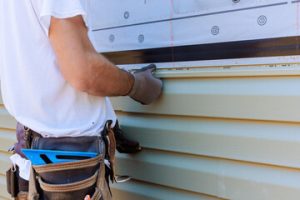Vinyl siding offers homeowners a range of benefits. Durable and easy to maintain, it resists rot, insects, and weather damage. Its strong insulating properties can boost energy efficiency and lower utility costs. It also adds value to the property and comes in a variety of colors, styles, and options for a seamless fit with the home aesthetic. If your vinyl siding is starting to fade, Siding Repair Charleston SC experts can replace the affected areas and restore the original beauty of your siding.

Cracks and Holes
Holes and cracks might seem like a small problem, but they can give pests an entry point into your home and allow moisture to cause rot or mold. It’s important to keep up with regular vinyl siding maintenance so that these problems don’t worsen.
Fortunately, it’s easy to repair holes or cracks in your vinyl siding by using exterior filler or caulk that matches your home’s color. First, wipe the area clean and make sure it’s free of any debris or dust that could interfere with the patching process. Then, de-gloss the surface and apply a coat of primer to ensure that the new caulk or filler will bond well with the vinyl. Let the primer dry for two to four hours before applying your filler or caulk. Use a plastic putty knife (rather than metal, which could damage the vinyl) to apply the filler and smooth it to match the texture of your siding. After the caulk has dried, sand it lightly with 100-grit sandpaper and then 220-grit to remove any rough patches. Finally, paint the patched area with exterior paint that matches your vinyl to make sure it blends in.
For larger holes in your vinyl, replacing the damaged panel is typically a better option than trying to patch it. However, this is a project that requires some experience with home improvement and may require a bit of investment in tools.
Warping
No material is perfect, and even the highly durable vinyl can experience some warping over time. This is often caused by heat exposure, especially in areas exposed to direct sunlight. If you can prevent excessive sun exposure by directing it away from the siding, or by adding shade with awnings, screens, trees, and shrubbery, this may help reduce warping and bulging.
Another common cause of warping is improper installation. If the vinyl is nailed down too tightly or is installed over a rotted area of the foundation, it may be restricted from expanding and contracting as it should, leading to deformation. This is often an issue with budget products that do not have adequate UV protection or stabilizers, so choosing a quality product that’s rated for your local climate can prevent warping issues.
When you notice wavy or warped siding, it’s essential to address the problem as soon as possible. Leaving the damage untreated can lead to water leaks into the home, which may cause mold or rot. It can also make it easier for insects to gain entry, and it can cause damage to the underlying structure of the house. A qualified contractor can quickly and easily repair these problems, ensuring that the damaged areas are stable and secure. This may involve loosening and realigning the siding panels to eliminate buckling and bending, or removing and replacing damaged sections of the vinyl.
Loose or Missing Pieces
Over time, strong winds can rip vinyl siding off your home. Even if only one panel is ripped, it exposes your home to moisture and pests. It also reveals any structural damage that may need to be addressed before more extensive damage occurs.
It’s important to check your siding regularly for signs of wear and tear, especially after heavy storms or high winds. Look for gaps between panels, missing fasteners, and areas with exposed nails or screws. If you find any loose sections, they should be reattached using construction adhesive and nail or screw reinforcements to ensure that the siding stays in place.
Holes and cracks in vinyl can be repaired with exterior-grade caulking that is designed to adhere to the textured surface of vinyl. Before applying the caulking, the damaged area should be roughed with 220-grit sandpaper and then thoroughly cleaned of dirt and debris.
Vinyl siding is designed to hold color for a long period of time, but faded vinyl can reduce the curb appeal of your home and affect your resale value.
Fading
Over time, harsh weather conditions and repeated exposure to the sun’s UV rays can cause vinyl siding to fade in color. This is a common problem and one that can diminish your home’s curb appeal. However, it’s easy to fix.
To restore your siding’s original color and shine, use a premium restoration product. These products are typically applied with a cloth or sponge and may contain UV inhibitors to help prevent future fading. Start by cleaning the affected area thoroughly to remove dirt, mildew, and other debris. Then, work in small sections and apply the restoration product per its instructions.
You can also repaint your vinyl siding to restore its appearance. Choose a color that complements your existing facade and follow the manufacturer’s instructions carefully to ensure proper application. You can also add an extra layer of protection by sealing your siding periodically to shield it from the sun’s UV rays.
To avoid fading, clean your vinyl siding regularly to remove dirt, mildew, and debris. You should also inspect your siding frequently for damage and repair it promptly to keep it looking good and prevent further problems. Additionally, be sure to trim back any overgrown vegetation around your house that could scratch or scrape your vinyl siding. Gutter cleaning is another important preventative measure that can reduce water-related issues like stains and water damage.